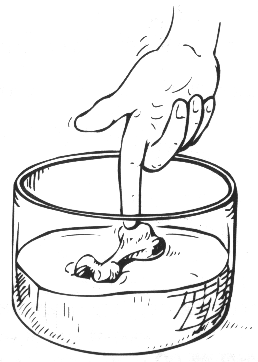Click here for a printable version
Title: Leaving a Trace
Level: Middle
Time: 2 Class Periods

Objective:
Gain visual understanding of what fossils are and how they are formed.
Materials:
-
500 mL fresh play dough (homemade or purchased)
- Empty margarine tub
-
60 mL vegetable oil
-
250 mL plaster of Paris (powder)
-
125 mL water
- Item to make a fossil cast of (chicken bone, leaf, stick, seed, plastic toy, etc.)
Activity:
- Pack the play dough into the empty margarine tub until it is about one half full. Make the surface smooth.
- Coat the item of which you are making a cast with a thin film of oil. Make sure it is thoroughly coated so the play dough will not stick to it.
- Press the object firmly into the play dough, making a clear, deep imprint.
- Remove the object and set the play dough aside for two days so you have a hard “fossil” mold.
- When completely hardened, coat the “fossil” mold with more oil, again making sure it is thoroughly covered.
- Mix the plaster of Paris and the water together (be sure to follow the safety precautions on the plaster of Paris box).
- Pour the mixture over the top of the mold and set aside to dry in a warm spot. This will take a few days but do not be impatient because the plaster must be completely set before being moved.
- When set, carefully separate the plaster and the play dough. Now you have a cast, which has the outward shape of the item used to make the mold.
Discussion:
The play dough represents the soft mud that was once the ground million of years ago. Plants and animals made imprints in this mud and if nothing filled them in before they hardened, the imprints eventually became fossil molds similar to the one you made. The plaster of Paris that you used represents the sediments that later filled in the molds and made cast fossils. Common cast fossils are leaf imprints, tree bark, and shells. Paleontologists can trace the history of our planet’s life millions of years ago by studying these fossils.
Adapted from EarthNet activities

